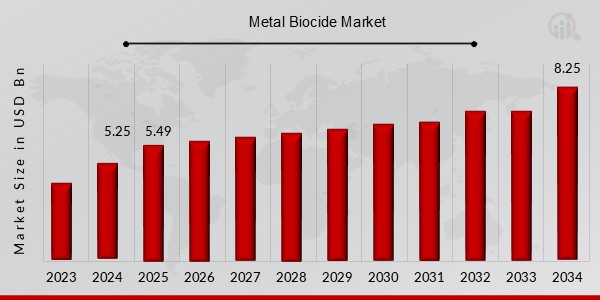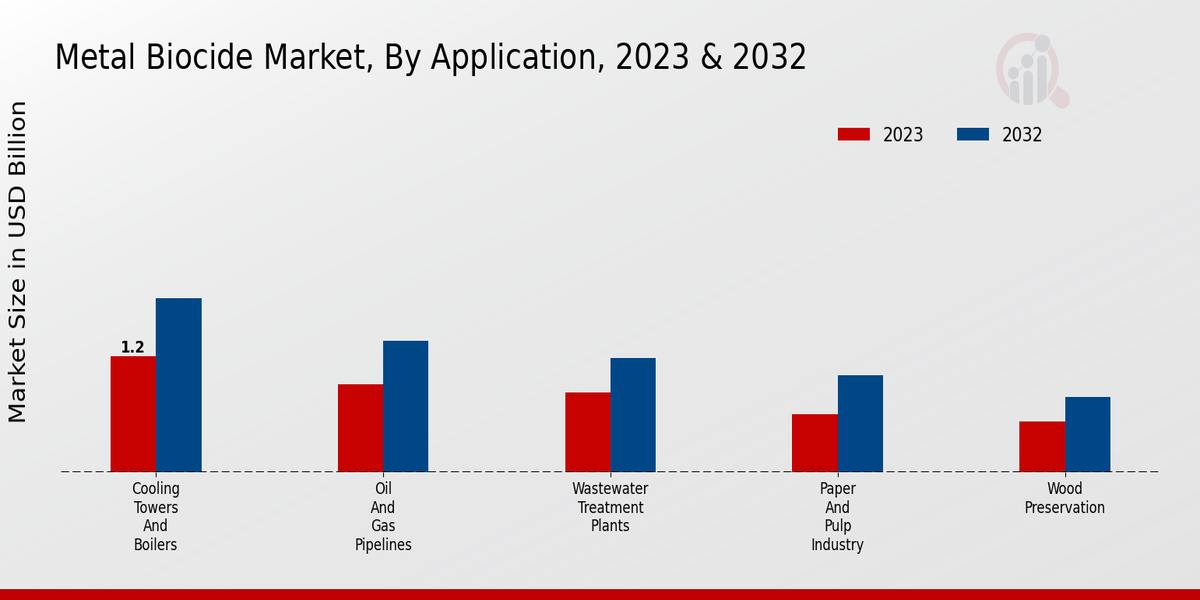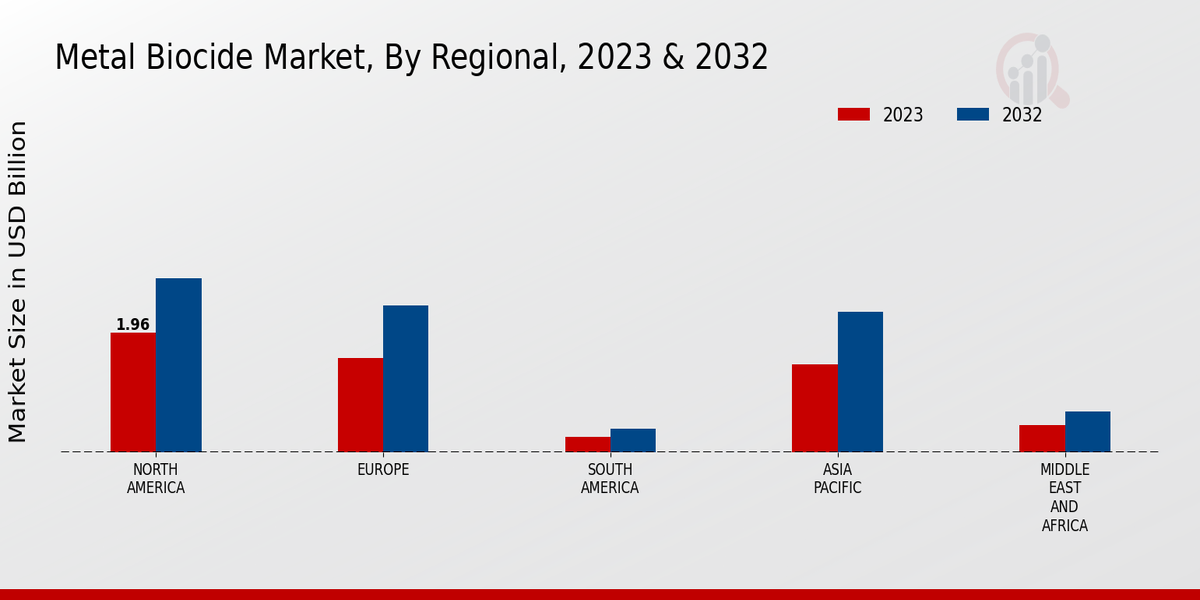Global Metal Biocide Market Overview
The Metal Biocide Market Size was estimated at 5.25 (USD Billion) in 2024. The Metal Biocide Industry is expected to grow from 5.49 (USD Billion) in 2025 to 8.25 (USD Billion) by 2034. The Metal Biocide Market CAGR (growth rate) is expected to be around 4.6% during the forecast period (2025 - 2034).

Source Primary Research, Secondary Research, MRFR Database and Analyst Review
Key Metal Biocide Market Trends Highlighted
Key Market DriversIncreasing prevalence of biofouling in industrial and marine environments, stringent regulatory norms for water treatment, and growing demand for biocide formulations in oil and gas industries are key drivers propelling the growth of the metal biocide market.Opportunities to be ExploredEmerging technologies such as nanotechnology and advanced biocide formulations offer significant opportunities for market expansion. The development of eco-friendly and sustainable metal biocides is expected to gain traction, meeting the increasing demand for environmentally conscious solutions.Recent TrendsSustainability The focus on environmental protection has led to the increased use of eco-friendly metal biocides, driving advancements in biodegradable and non-toxic formulations.Innovation Ongoing research and development have resulted in the introduction of novel biocides with enhanced efficacy and reduced environmental impact.Regulatory Compliance Stringent regulations for biofouling control have intensified the adoption of metal biocides, particularly in the marine and water treatment industries.
Metal Biocide Market Drivers
Increasing Demand for Metal Biocides in Industrial Water Treatment
Metal biocides are essential for controlling and preventing the growth of microorganisms in industrial water systems. The rising demand for metal biocides is attributed to the growing awareness of the adverse effects of microbial contamination in industrial water systems. Microbial contamination can lead to corrosion, fouling, and other problems that can reduce the efficiency and lifespan of industrial equipment. Metal biocides are effective in controlling the growth of microorganisms and protecting industrial water systems from these problems. The increasing demand for metal biocides in industrial water treatment is expected to continue in the coming years.This is due to the growing number of industrial facilities, the increasing use of water-intensive processes, and the stricter environmental regulations. Metal biocides are an essential part of industrial water treatment programs and play a vital role in protecting industrial water systems from microbial contamination. The Metal Biocide Market Industry is expected to witness significant growth in the coming years. The market is driven by the increasing demand for metal biocides in various industries, such as oil and gas, power generation, and manufacturing.The growing awareness of the importance of water treatment is also contributing to the growth of the market. The increasing demand for metal biocides in industrial water treatment is expected to continue in the coming years. This is due to the growing number of industrial facilities, the increasing use of water-intensive processes, and the stricter environmental regulations. Metal biocides are an essential part of industrial water treatment programs and play a vital role in protecting industrial water systems from microbial contamination.
Rising Environmental Concerns
The growing environmental concerns are another major factor driving the growth of the Metal Biocide Market Industry. Metal biocides are used to control the growth of microorganisms in industrial water systems, which can help to reduce the environmental impact of these systems. Metal biocides can help to prevent the formation of biofilms, which can lead to corrosion and other problems. They can also help to reduce the amount of organic matter in water, which can improve water quality and reduce the risk of environmental pollution.
Technological Advancements
The Metal Biocide Market Industry is also benefiting from technological advancements. New technologies are being developed that make metal biocides more effective and environmentally friendly. For example, some new metal biocides are being developed that are more effective at controlling the growth of specific types of microorganisms. Other new metal biocides are being developed that are more biodegradable and less toxic to the environment.
Metal Biocide Market Segment Insights
Metal Biocide Market Application Insights
The application segment of the Metal Biocide Market holds immense significance, as it represents the diverse industries that utilize metal biocides to combat microbial growth and corrosion in various systems. Among the key applications, cooling towers and boilers account for a significant share of the market. The growing demand for efficient cooling systems in industries such as power generation, manufacturing, and data centers drives the segment's growth. Metal biocides effectively prevent the formation of biofilm and microbial contamination, ensuring optimal heat transfer and system longevity.Oil and gas pipelines constitute another substantial segment, driven by the increasing need for corrosion control in aging infrastructure and the expansion of pipeline networks globally. Metal biocides play a crucial role in protecting pipelines from microbial-induced corrosion (MIC), which can lead to costly leaks and operational disruptions. The wastewater treatment plants segment is also experiencing growth due to the rising demand for effective wastewater disinfection and odor control. Metal biocides aid in eliminating harmful bacteria and pathogens, ensuring compliance with environmental regulations and safeguarding public health.The paper and pulp industry relies heavily on metal biocides to prevent slime formation and microbial degradation of paper products. These biocides effectively control bacteria and fungi, improving paper quality and reducing production downtime. Wood preservation is another significant application, as metal biocides protect wooden structures from decay and insect infestation, extending their lifespan and reducing maintenance costs. Finally, the textile manufacturing segment utilizes metal biocides to prevent microbial growth on textiles, ensuring product quality and hygiene.In terms of market size, the cooling towers and boilers segment is projected to reach a valuation of 1.2 billion USD by 2024. The oil and gas pipelines segment is expected to grow at a CAGR of 4.5%, reaching a market size of 950 million USD by 2024. The wastewater treatment plants segment is expected to witness a steady growth, with a market size of 820 million USD projected for 2024. The paper and pulp industry segment is expected to reach a valuation of 600 million USD by 2024, while the wood preservation segment is anticipated to grow at a CAGR of 3.8%, reaching a market size of 520 million USD by 2024.The textile manufacturing segment is expected to contribute 480 million USD to the metal biocide market by 2024.

Source Primary Research, Secondary Research, MRFR Database and Analyst Review
Metal Biocide Market Biocide Type Insights
The Metal Biocide Market is segmented by Biocide Type into Organic Biocides and Inorganic Biocides. Organic Biocides are expected to hold a significant market share in 2023, owing to their broad-spectrum activity and effectiveness against a wide range of microorganisms. Isothiazolinones and glutaraldehyde are the most commonly used organic biocides in the Metal Biocide Market. Inorganic Biocides, such as chlorine and bromine, are also widely used due to their cost-effectiveness and strong oxidizing properties. The demand for inorganic biocides is expected to grow in the coming years, particularly in the water treatment and metalworking industries.
Metal Biocide Market Metal Type Insights
The Metal Biocide Market segmentation by Metal Type comprises Copper, Iron, Steel, Stainless Steel, and Aluminum. Among these, Copper held the largest revenue share in 2023, and it is projected to maintain its dominance throughout the forecast period. The growth of the copper segment can be attributed to its extensive usage in various industries, including construction, automotive, and electrical. Aluminum is another significant segment, owing to its lightweight and corrosion-resistant properties, which make it suitable for applications in aerospace, automotive, and packaging industries.The rising demand for metal biocides in these industries is expected to drive the growth of the Metal Biocide Market over the coming years.
Metal Biocide Market End User Industry Insights
The End User Industry segment plays a crucial role in shaping the Metal Biocide Market. Among the key end users, Industrial and Manufacturing hold a significant market share, driven by the growing need for metal protection in various industrial processes, including metalworking, oil & gas, and power generation. The Utilities segment is also witnessing substantial growth due to increasing demand for metal biocides in cooling systems, boilers, and heat exchangers. Water Treatment is another important end user, with metal biocides being essential for controlling microbial growth in water distribution systems, wastewater treatment plants, and industrial water systems.The Construction segment is expected to contribute significantly to the market growth, as metal biocides are used to protect metal structures from corrosion and extend their lifespan.
Metal Biocide Market Regional Insights
The regional landscape of the Metal Biocide Market exhibits distinct growth patterns across various geographical segments. North America and Europe collectively account for a significant share of the market, driven by stringent environmental regulations and the presence of major industrial hubs. In 2023, North America held a dominant position with a market size of USD 1.96 billion, while Europe followed closely with a market value of USD 1.54 billion. The Asia-Pacific (APAC) region is anticipated to witness substantial growth over the forecast period, owing to the flourishing manufacturing sector and increasing demand for metal biocides in emerging economies such as China and India.South America and the Middle East and Africa (MEA) regions are expected to exhibit moderate growth, influenced by the rising adoption of metal biocides in various industries.

Source Primary Research, Secondary Research, MRFR Database and Analyst Review
Metal Biocide Market Key Players And Competitive Insights
Major players in Metal Biocide Market industry are constantly striving to develop innovative and effective products to meet the evolving needs of their customers. Leading Metal Biocide Market players are investing in research and development to enhance the performance and safety of their products. This competitive landscape is driving Metal Biocide Market development and innovation, resulting in the introduction of new and improved solutions for metal protection.BASF SE is a leading player in the Metal Biocide Market. The company offers a wide range of metal biocides under the brand name Cortec. Cortec products are designed to protect metals from corrosion, pitting, and other forms of degradation. BASF SE has a strong presence with manufacturing facilities in Europe, North America, and Asia. The company's extensive distribution network ensures that its products are readily available to customers worldwide.LANXESS is another key player in the Metal Biocide Market. The company's SalTec brand of metal biocides is known for its high efficacy and long-lasting protection. LANXESS has a strong focus on sustainability and offers environmentally friendly metal biocides that meet the latest regulations. The company has a reach with production sites in Germany, Brazil, and China. LANXESS is committed to providing innovative and reliable solutions to its customers in the metalworking industry.
Key Companies in the Metal Biocide Market Include
- Trojan Technologies
- Borealis AG
- Evonik Industries AG
- 3M Company
- Buckman Laboratories International, Inc.
- Halliburton
- ChemTreat, Inc.
- Thor Specialties, Inc.
- BioLab, Inc.
- BASF SE
- Lonza
- The Dow Chemical Company
- Shanghai Control Chemical limited
- Albemarle Corporation
- Veolia Water Technologies & Solutions
Metal Biocide Market Industry Developments
Rising demand for metal biocides in various industries, including oil and gas, power generation, and manufacturing, is driving market growth. Increasing awareness about the harmful effects of microbial growth on metal surfaces and the growing adoption of eco-friendly biocides are further contributing to market expansion. The market is witnessing a surge in demand for biocides effective against sulfate-reducing bacteria (SRB) and acid-producing bacteria (APB), particularly in the oil and gas sector. Key players are focusing on developing innovative and sustainable biocide solutions to cater to the evolving needs of end-use industries.
Metal Biocide Market Segmentation Insights
-
Metal Biocide Market Application Outlook
-
Metal Biocide Market Biocide Type Outlook
-
Organic Biocides (e.g., isothiazolinones, glutaraldehyde)
-
Inorganic Biocides (e.g., chlorine, bromine)
-
Metal Biocide Market Metal Type Outlook
-
Copper
-
Iron
-
Steel
-
Stainless Steel
-
Aluminum
-
Metal Biocide Market End User Industry Outlook
-
Metal Biocide Market Regional Outlook
-
North America
-
Europe
-
South America
-
Asia Pacific
-
Middle East and Africa
| Report Attribute/Metric |
Details |
| Market Size 2024 |
5.25 (USD Billion) |
| Market Size 2025 |
5.49 (USD Billion) |
| Market Size 2034 |
8.25 (USD Billion) |
| Compound Annual Growth Rate (CAGR) |
4.6% (2025 - 2034) |
| Report Coverage |
Revenue Forecast, Competitive Landscape, Growth Factors, and Trends |
| Base Year |
2024 |
| Market Forecast Period |
2025 - 2034 |
| Historical Data |
2020 – 2024 |
| Market Forecast Units |
USD Billion |
| Key Companies Profiled |
Trojan Technologies, Borealis AG, Evonik Industries AG, 3M Company, Buckman Laboratories International, Inc., Halliburton, ChemTreat, Inc., Thor Specialties, Inc., BioLab, Inc., BASF SE, Lonza, The Dow Chemical Company, Shanghai Control Chemical limited, Albemarle Corporation, Veolia Water Technologies & Solutions |
| Segments Covered |
Application, Biocide Type, Metal Type, End User Industry, Regional |
| Key Market Opportunities |
Growing demand for metal protection Increasing use in healthcare Expansion of metal-based industries Rising environmental concerns Technological advancements |
| Key Market Dynamics |
Economic growth rising demand from emerging markets strict environmental regulations technological advancements growing awareness about hygiene and sanitation |
| Countries Covered |
North America, Europe, APAC, South America, MEA |
Frequently Asked Questions (FAQ) :
The Metal Biocide Market is expected to reach a valuation of approximately 5.25 billion USD in 2024.
The Metal Biocide Market is projected to grow at a CAGR of 4.6% from 2025 to 2034.
North America is the largest regional segment of the Metal Biocide Market, accounting for a significant share of the market.
Metal biocides are primarily used in industrial water treatment, oil and gas, and personal care products.
Key competitors in the Metal Biocide Market include BASF, Dow, Lonza, and Buckman.
Growing demand for metal biocides in industrial water treatment and increasing awareness of the importance of hygiene are major factors driving the market growth.
Stringent environmental regulations and the development of resistant microorganisms pose challenges to the growth of the market.
The Metal Biocide Market is projected to reach a valuation of approximately 8.25 Billion USD by 2034.
Increasing adoption of green and sustainable metal biocides and the emergence of nanotechnology-based solutions are key trends shaping the market.
Unexplored applications in emerging markets and the development of innovative metal biocide formulations present potential growth opportunities.

















